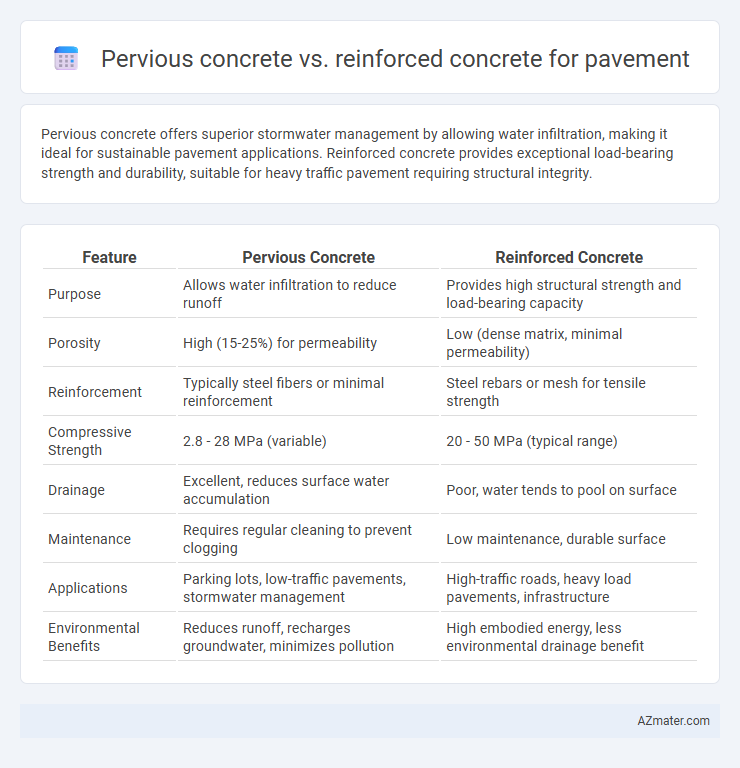Pervious concrete offers superior stormwater management by allowing water infiltration, making it ideal for sustainable pavement applications. Reinforced concrete provides exceptional load-bearing strength and durability, suitable for heavy traffic pavement requiring structural integrity.
Table of Comparison
| Feature | Pervious Concrete | Reinforced Concrete |
|---|---|---|
| Purpose | Allows water infiltration to reduce runoff | Provides high structural strength and load-bearing capacity |
| Porosity | High (15-25%) for permeability | Low (dense matrix, minimal permeability) |
| Reinforcement | Typically steel fibers or minimal reinforcement | Steel rebars or mesh for tensile strength |
| Compressive Strength | 2.8 - 28 MPa (variable) | 20 - 50 MPa (typical range) |
| Drainage | Excellent, reduces surface water accumulation | Poor, water tends to pool on surface |
| Maintenance | Requires regular cleaning to prevent clogging | Low maintenance, durable surface |
| Applications | Parking lots, low-traffic pavements, stormwater management | High-traffic roads, heavy load pavements, infrastructure |
| Environmental Benefits | Reduces runoff, recharges groundwater, minimizes pollution | High embodied energy, less environmental drainage benefit |
Introduction to Pervious Concrete and Reinforced Concrete Pavements
Pervious concrete pavements enhance stormwater management by allowing water to infiltrate through their porous structure, reducing runoff and promoting groundwater recharge. Reinforced concrete pavements utilize steel reinforcement bars to increase tensile strength and durability, making them ideal for heavy traffic loads and long-term structural performance. Both pavement types offer distinct benefits: pervious concrete focuses on environmental sustainability and permeability, while reinforced concrete ensures superior load-bearing capacity and longevity.
Composition and Material Differences
Pervious concrete for pavement consists of a mixture with little to no fine aggregates, primarily using coarse aggregates, cement, water, and minimal fines to create a porous structure that allows water infiltration. Reinforced concrete combines Portland cement, fine and coarse aggregates, water, and steel reinforcement bars or mesh to enhance tensile strength and durability. The key material difference lies in pervious concrete's open-void structure aimed at permeability, while reinforced concrete prioritizes compressive and tensile strength with its dense matrix and steel reinforcement.
Structural Performance Comparison
Pervious concrete offers excellent drainage and reduces surface runoff, but it typically has lower compressive strength and durability compared to reinforced concrete in pavement applications. Reinforced concrete provides superior structural performance, including higher load-bearing capacity, resistance to cracking, and longevity under heavy traffic conditions due to steel reinforcement. The choice between the two depends on balancing the need for permeability with structural demands, where reinforced concrete remains the preferred solution for high-stress pavement environments.
Permeability and Drainage Capabilities
Pervious concrete offers superior permeability and drainage capabilities compared to reinforced concrete, allowing water to pass through its porous structure and reducing surface runoff. Reinforced concrete, with a dense matrix and steel reinforcement, typically has low permeability, leading to poor drainage and potential water accumulation issues in pavement applications. The enhanced permeability of pervious concrete makes it ideal for sustainable urban drainage systems, reducing stormwater runoff and mitigating flooding risks.
Environmental Impact and Sustainability
Pervious concrete significantly reduces stormwater runoff and promotes groundwater recharge, making it an environmentally sustainable choice for pavement compared to traditional reinforced concrete, which often leads to increased surface runoff and potential flooding. The permeability of pervious concrete also lowers the urban heat island effect by allowing water to infiltrate and cool the pavement surface, whereas reinforced concrete surfaces tend to absorb and retain more heat. Sustainable infrastructure projects increasingly prefer pervious concrete for its ability to mitigate environmental damage while maintaining structural performance in pavement applications.
Installation Methods and Construction Practices
Pervious concrete pavement installation requires careful placement to maintain its porosity, typically involving slower, more meticulous pouring and vibration techniques to prevent clogging of voids. Reinforced concrete pavements demand precise rebar placement and alignment within the formwork before concrete pouring to ensure structural integrity and load distribution. Both methods necessitate controlled curing processes, but pervious concrete often needs additional attention to avoid contamination that could reduce permeability.
Cost Analysis: Initial and Lifecycle Costs
Pervious concrete typically incurs higher initial costs than reinforced concrete due to specialized materials and installation techniques required for its porous structure. Lifecyle cost analysis often reveals lower maintenance expenses for pervious concrete, attributed to its superior stormwater management reducing pavement damage over time. Reinforced concrete involves greater upfront investment in steel reinforcement, but may experience increased long-term repair costs from water-related deterioration.
Maintenance Requirements and Longevity
Pervious concrete pavements require more frequent maintenance to address clogging and ensure proper permeability, while reinforced concrete offers greater durability with lower routine upkeep due to its resistance to cracking and structural stress. Reinforced concrete typically outlasts pervious concrete in high-traffic applications, providing a longevity of 30 to 50 years compared to pervious concrete's 10 to 20 years, depending on maintenance practices. Proper sealing and regular vacuuming extend the lifespan of pervious pavements, but reinforced concrete's inherent strength reduces the need for such intensive interventions.
Typical Applications and Suitability
Pervious concrete, characterized by its high permeability, is ideal for pavements requiring efficient stormwater management, such as parking lots, pedestrian walkways, and low-traffic roads, promoting groundwater recharge and reducing runoff. Reinforced concrete is suited for high-load bearing pavements like highways, airport runways, and heavy industrial areas where structural strength and durability are critical. Selecting between pervious and reinforced concrete depends on the balance between permeability needs and load-bearing requirements in pavement applications.
Conclusion: Choosing the Right Concrete for Pavement
Pervious concrete offers superior stormwater management and reduces runoff by allowing water to infiltrate the pavement, making it ideal for sustainable urban infrastructure. Reinforced concrete provides exceptional strength and durability for heavy traffic loads and long-term structural performance in pavement applications. The choice between pervious and reinforced concrete depends on project-specific requirements such as load-bearing capacity, environmental impact, and maintenance considerations.

Infographic: Pervious concrete vs Reinforced concrete for Pavement
 azmater.com
azmater.com